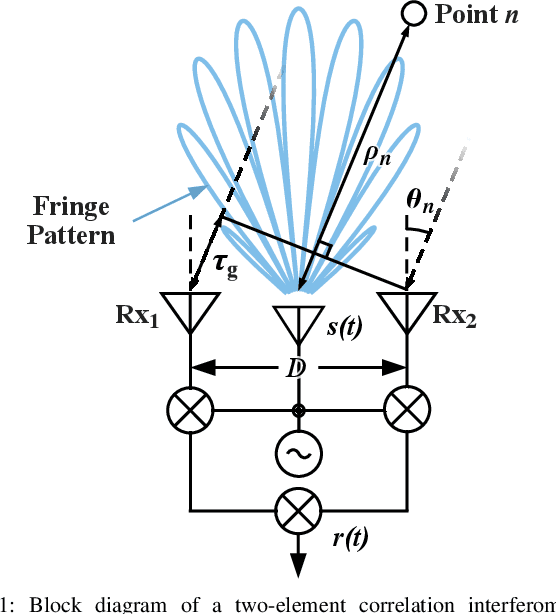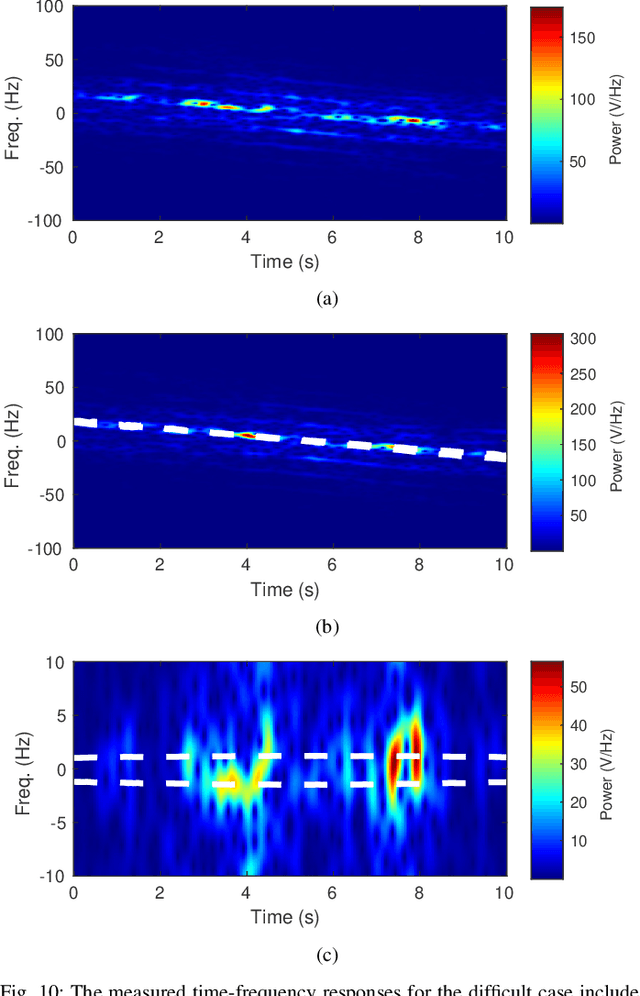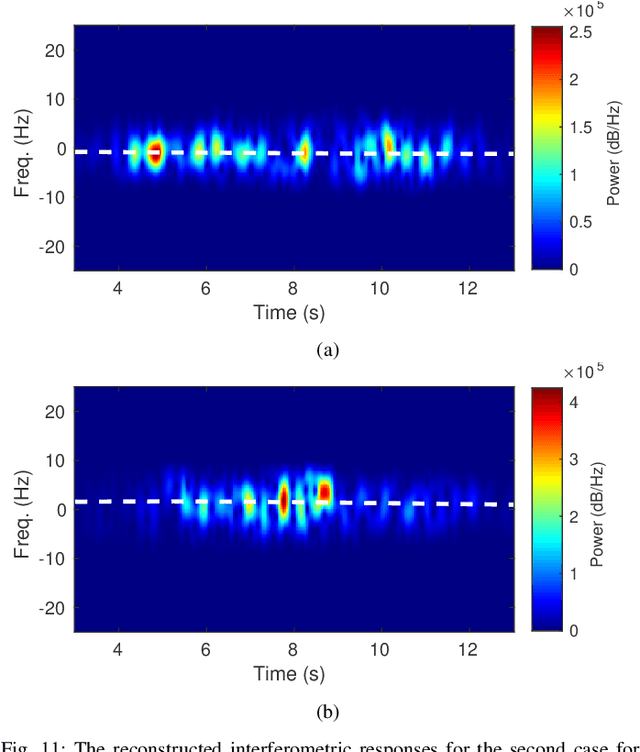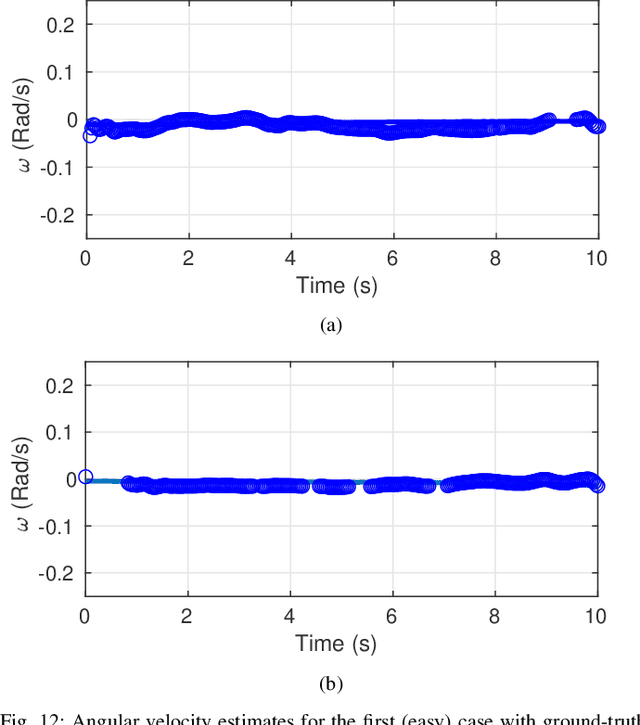Jason M. Merlo
Decentralized Picosecond Synchronization for Distributed Wireless Systems
May 28, 2024Abstract:We demonstrate a wireless, decentralized time-alignment method for distributed antenna arrays and distributed wireless networks that achieves picosecond-level synchronization. Distributed antenna arrays consist of spatially separated antennas that coordinate their functionality at the wavelength level to achieve coherent operations such as distributed beamforming. Accurate time alignment (synchronization) of the local clocks on each node in the array is necessary to support accurate time-delay beamforming of modulated signals. In this work we combine a consensus averaging algorithm and a high-accuracy wireless two-way time transfer method to achieve decentralized time alignment, correcting for the time-varying bias of the clocks in a method that has no central node. Internode time transfer is based on a spectrally-sparse, two-tone signal achieving near-optimal time delay accuracy. We experimentally demonstrate the approach in a wireless four-node software-defined radio system, with various network connectivity graphs. We show that within 20 iterations all the nodes achieve convergence within a bias of less than 12 ps and a standard deviation of less than 3 ps. The performance is evaluated versus the bandwidth of the two-tone waveform, which impacts the synchronization error, and versus the signal-to-noise ratio.
Design of a Single-Element Dynamic Antenna for Secure Wireless Applications
Dec 23, 2022Abstract:We introduce a new technique for secure wireless applications using a single dynamic antenna. The dynamic antenna supports a constantly changing current distribution that generates a radiation pattern that is static in a desired direction and dynamic elsewhere, thereby imparting additional modulation on the signal and obscuring information transmitted or received outside of the secure spatial region. Dynamic currents are supported by a single feed that is switched between separate ports on a single antenna, generating two different radiation patterns. We introduce the theoretical concept by exploring an ideal complex dynamic radiation pattern that remains static in a narrow desired direction and is dynamic elsewhere. The impact on the transmission of information is analyzed, showing that the secure region narrows as the modulation order increases, and design constraints on the spatial width of the secure region as a function of modulation format are determined. We design and analyze a 2.3 GHz two-state dynamic dipole antenna and experimentally demonstrate secure wireless transmission. We show the ability to steer the secure region experimentally, and to maintain high throughput in the secure region while obscuring the information elsewhere. Our approach introduces a novel single-element technique for secure wireless applications that can be used independently from the rest of the wireless system, essentially operating as a $``$black box$"$ for an additional layer of security.
Wireless Picosecond Time Synchronization for Distributed Antenna Arrays
Jun 16, 2022



Abstract:Distributed antenna arrays have been proposed for many applications ranging from space-based observatories to automated vehicles. Achieving good performance in distributed antenna systems requires stringent synchronization at the wavelength and information level to ensure that the transmitted signals arrive coherently at the target, or that scattered and received signals can be appropriately processed via distributed algorithms. In this paper we address the challenge of high precision time synchronization to align the operations of elements in a distributed antenna array and to overcome time-varying bias between platforms due to oscillator drift. We use a spectrally sparse two-tone waveform, which obtains approximately optimal time estimation accuracy, in a two-way time transfer process. We also describe a technique for determining the true time delay using the ambiguous two-tone matched filter output, and we compare the time synchronization precision of the two-tone waveform with the more common linear frequency modulation (LFM) waveform. We experimentally demonstrate wireless time synchronization using a single pulse 40$\,$MHz two-tone waveform over a 90$\,$cm 5.8$\,$GHz wireless link in a laboratory setting, obtaining a timing precision of 2.26$\,$ps.
Distortion Mitigation in Millimeter-Wave Interferometric Radar Angular Velocity Estimation Using Signal Response Decomposition
Dec 17, 2021



Abstract:A new method of distortion mitigation for multitarget interferometric angular velocity estimation in millimeter-wave radar is presented. In general, when multiple targets are present, the response of a correlation interferometer is corrupted by intermodulation distortion, making it difficult to estimate individual target angular velocities. We present a distortion mitigation method that works by decomposing the responses at each antenna element into the responses from the individual targets. Data association is performed to match individual target responses at each antenna such that cross-correlation is performed only between associated targets. Thus, the intermodulation distortion (cross-terms) from correlating unlike targets are eliminated, and the result is a frequency response whose individual frequencies are proportional to the angular velocities of the targets. We demonstrate the approach with a custom 40 GHz interferometric radar, a high-accuracy motion capture system which provides ground-truth position measurements, and two robotic platforms. The multitarget experiments consist of three scenarios, designed to represent easy, medium, and difficult cases for the distortion mitigation technique. We show that the reduction in distortion yields angular velocity estimation errors in the three cases of less than $0.008$ rad/s, $0.020$ rad/s, and $0.033$ rad/s for the easy, medium, and hard cases, respectively.
 Add to Chrome
Add to Chrome Add to Firefox
Add to Firefox Add to Edge
Add to Edge